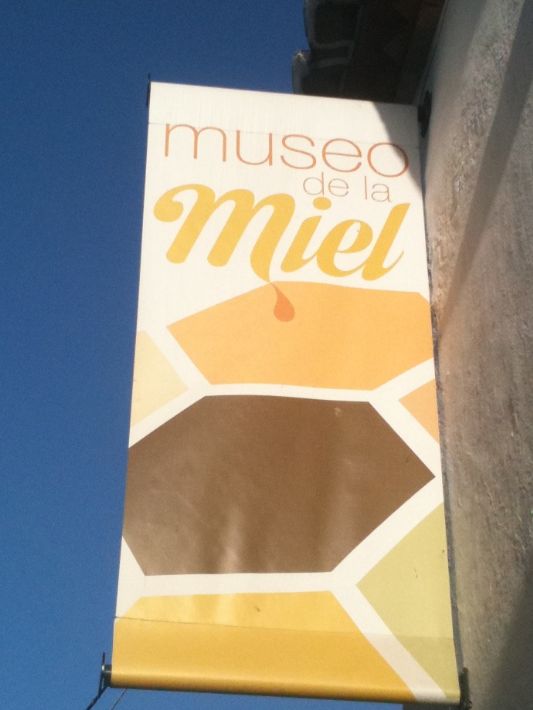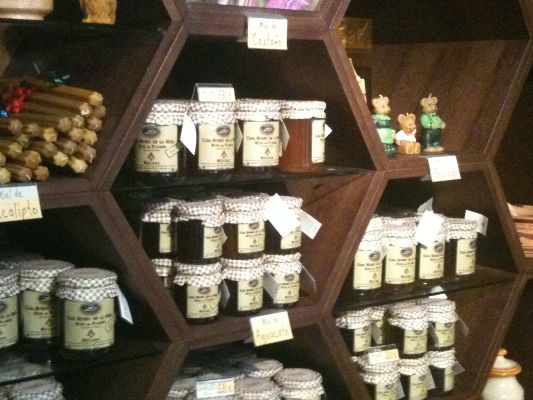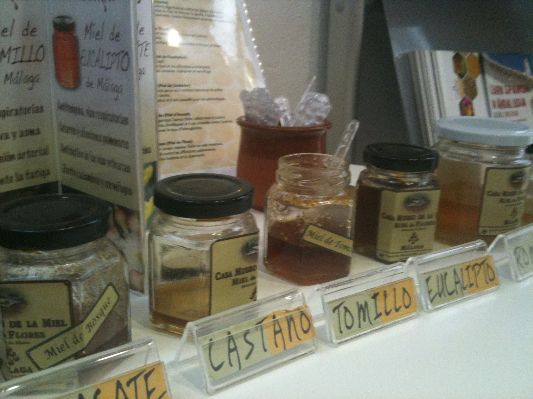Avocado honey? Sounds a bit odd. Is it honey mixed with avocado? Is it sweet or savoury? No that’s silly – it’s honey made from pollen collected largely from the blossom of avocado trees.
The point about avocado honey is that it boosts your iron levels. And as someone whose blood is occasionally deemed to be slightly too deficient in iron to be collected tor others to use, I felt mine needed a boost. I knew that honey was, in the general scheme of things, good for me. What I didn’t realise was that different honey is good for different bits of me.
 So I took myself off to El Museo de Miel in the next street along from mine. The Museum of Honey. Colmena means beehive, and Colmenar is the beehive of the Axarquía region. Thousands of acres of nut and fruit trees and acres of flowering herbs provide the perfect environment for the bees, and dozens of local producers combine into la asociación Malagueña de apicultores, the association of Málaga beekeepers, based here in Colmenar. The museum itself has wonderful displays, is very well-organised, and the film you watch can be played in Spanish, English or German. Over-60s get in very cheap – don’t forget to ask for your discount.
So I took myself off to El Museo de Miel in the next street along from mine. The Museum of Honey. Colmena means beehive, and Colmenar is the beehive of the Axarquía region. Thousands of acres of nut and fruit trees and acres of flowering herbs provide the perfect environment for the bees, and dozens of local producers combine into la asociación Malagueña de apicultores, the association of Málaga beekeepers, based here in Colmenar. The museum itself has wonderful displays, is very well-organised, and the film you watch can be played in Spanish, English or German. Over-60s get in very cheap – don’t forget to ask for your discount.
 The shop at the honey museum is a monument to creativity – more things made of honey than you could ever have imagined. The honey sweets are delicious. The soap is beautifully scented and creamy and smells good enough to eat. There are candles and other beeswax products. Jars of pollen! But I’ve no idea what to do with it.
The shop at the honey museum is a monument to creativity – more things made of honey than you could ever have imagined. The honey sweets are delicious. The soap is beautifully scented and creamy and smells good enough to eat. There are candles and other beeswax products. Jars of pollen! But I’ve no idea what to do with it.
And the tasting pots …… oh, those tasting pots! Little spatulas to try all the flavours – what a lovely way to waste half an hour!
Some of their claims for the medicinal benefits seem a little far-fetched, but even taken with a pinch of pollen they do give an indication of the type of ailment for which each honey is meant to be particularly effective.
Miel de Azahar – Orange-blossom honey. It has anti-spasm properties and is a soothing relaxant. Calms sleeping children and the elderly.
Miel de Romero – Rosemary honey. For heartburn, stomach ulcers, liver disease, cirrhosis, gout, epilepsy, rheumatism and dizziness. It counters physical and intellectual exhaustion.
 Miel de Tomillo – Thyme honey. For respiritory ailments, convulsive coughing and asthma. It regulates blood pressure and prevents fatigue.
Miel de Tomillo – Thyme honey. For respiritory ailments, convulsive coughing and asthma. It regulates blood pressure and prevents fatigue.
Miel de Eucalipto – Eucalyptus honey. Effective against coughs, colds, urinary tract infections and intestinal worms. Clears airways.
Miel de Castaño – Chestnut honey. Rich in iron and tannins, good for circulation. Recommended for asthmatics. Strong taste.
Miel de Aguacate – Avocado blossom honey. Rich in organic iron. Prevents anaemia. Increases haemoglobin, and has diuretic properties. Strongly-flavoured, best used in cooking.
Miel de Bosque – Honey of the Forest. Rich in mineral salts, recommended for pulmonary infection, anaemia and dysentery. Dense flavour.
Miel de Milflores – Thousand-flower honey. An anti-inflammatory, helps digestion and healing, and increases energy and physical strength.
The honey museum has also given me a greater understanding of the campo that I walk through. As each type of tree or bush gives way to another, I try to identify them and the honey that the bees produce from them.
.JPG) In the end though, it’s not going to be about whether I feel especially gouty one morning, need to evict some intestinal worms or wish to calm a sleeping child (why would there be a need for that?), it’s going to be about the taste. I suppose I will work my way through them all in time, but so far I have tried only two - the Aguacate which may well have boosted my iron but which I found too strongly-flavoured for my taste, and the Milflores which is simply lovely. I’m not in immediate need of an anti-inflammatory, and I haven’t noticed an increase in physical strength, but it’s certainly yummy with a fresh bollo, a breakfast roll, and that’s what counts.
In the end though, it’s not going to be about whether I feel especially gouty one morning, need to evict some intestinal worms or wish to calm a sleeping child (why would there be a need for that?), it’s going to be about the taste. I suppose I will work my way through them all in time, but so far I have tried only two - the Aguacate which may well have boosted my iron but which I found too strongly-flavoured for my taste, and the Milflores which is simply lovely. I’m not in immediate need of an anti-inflammatory, and I haven’t noticed an increase in physical strength, but it’s certainly yummy with a fresh bollo, a breakfast roll, and that’s what counts.
© Tamara Essex 2012